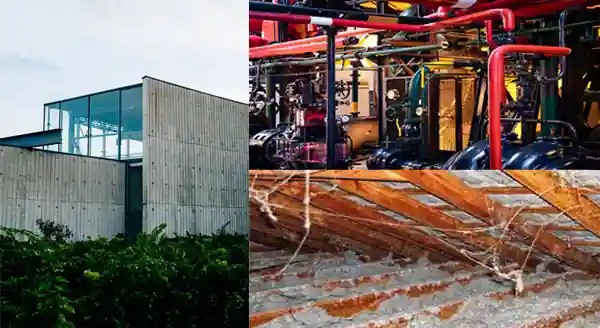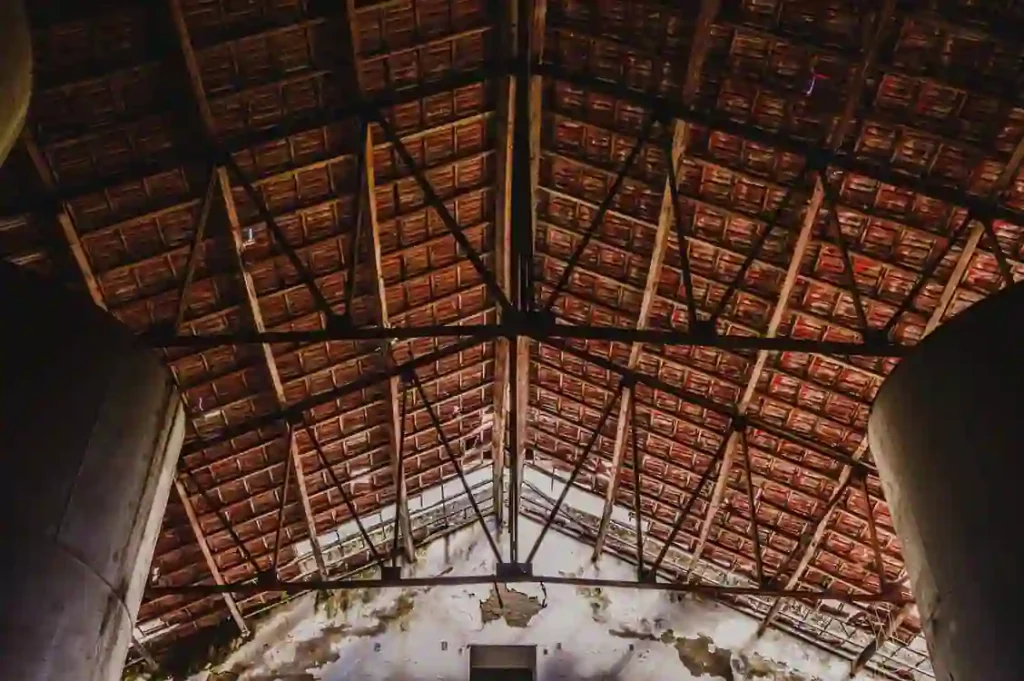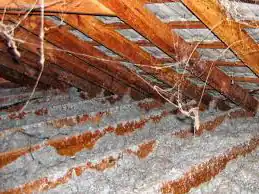Different types of asbestos insulation – A Comprehensive Guide to Understanding Asbestos Insulation Types
First of all, Once acclaimed for its ability to withstand heat and act as an insulator, asbestos is now considered a hazardous material since it has been linked to lung cancer and mesothelioma, two significant health issues. Materials containing asbestos are still used in older structures, especially in insulation, even though they are prohibited in many countries. We’ll go over the several kinds of asbestos insulation, their characteristics, dangers, and safe handling and disposal procedures in this extensive tutorial. Asbestos: What is it? Asbestos is recognized by its fibrous texture. According to research throughout the 20th century, asbestos was commonly used in various industries, including manufacturing, insulation, and establishing, because of its durability and resistance to fire.
Asbestos mineral types include actinolite, tremolite, anthophyllite, crocidolite (blue asbestos), amosite (brown asbestos), and chrysotile (white asbestos).
Features of Insulation Made of Asbestos
First, we can see what are the main features of the Asbestos Insulation. It will help to understand clearly all about the Asbestos Insulation. Let’s see the detailed information about the features of Asbestos Insulation, because asbestos best features it is mostly used to insulate the attic, we provided detailed information about that, in Asbestos Insulation In Attic, this post.
Heat Resistance:- Features of Asbestos Insulation
The importance of asbestos insulation stemmed from its capacity to endure high temperatures, which made it ideal for use in boilers, furnaces, and pipes.
Insulating Properties-
The exceptional insulating qualities of asbestos fibres make them a popular choice for thermal insulation materials.
Asbestos Insulation Types
Here in the following passage, we cover the point- A Comprehensive Overview of Asbestos Insulation Types and Their Applications. First of all, Once valued for its insulating and heat-resistant qualities, asbestos is a naturally occurring mineral. However, because it has been linked to serious health issues, asbestos is now considered a hazardous material. Compared with other insulation materials, Asbestos has been used widely in insulation in a variety of forms, but when disturbed, it poses serious health concerns to people, this is the back point of this insulation material. So here We’ll examine the many forms of asbestos insulation in this blog post, along with its uses, properties, and potential health risks.
Asbestos-containing Pipe Insulation:- Asbestos Insulation Types

In residential, commercial, and industrial settings, asbestos pipe insulation was a common method of pipe insulation. It prevented condensation and protected from heat loss.
Look:
Typically, asbestos pipe insulation is wrapped around pipes in the form of a fibrous, corrugated substance. It could have a grey or white hue.
Risks:
Asbestos pipe insulation can emit airborne fibres when broken or disturbed during restoration or maintenance work, putting tenants at risk of inhaling them.
Asbestos-containing Attic and Wall Insulation- Asbestos Insulation Types

Description: To improve thermal efficiency, older homes and structures often had loose-fill asbestos insulation placed in their walls and attics.
Look: Asbestos insulation with loose fill looks like fluffy grey or brown stuff or vermiculite. It could be dispersed over attic levels or in the spaces between wall studs.
Risks: When wall or attic insulation is disturbed, as happens when remodelling or upgrading insulation, asbestos fibres may be released into the home.
Asbestos-containing Refrigeration or HVAC Insulation:
Heating, ventilation, and air conditioning (HVAC) systems frequently use asbestos insulation to insulate air handlers, boilers, and ducting.
Look: Asbestos HVAC insulation comes in a variety of shapes and sizes, such as tape, cloth, or corrugated paper, and it’s frequently covered in a white or grey substance.
Risks: If asbestos HVAC insulation deteriorates or is damaged, asbestos fibres may be released into air ducts and could contaminate the ventilation system of the entire structure.
Ceiling tiles containing asbestos and insulation made of vermiculite:
Asbestos was also used to make ceiling tiles and a part of the vermiculite insulation that is frequently used to insulate attics.
Look: Ceiling tiles that have asbestos in them may have a rough surface that shows visible fibres. Asbestos-containing vermiculite insulation might have tiny, greyish-brown particles in it.
Dangers: When asbestos-containing ceiling tiles or vermiculite insulation are disturbed, asbestos fibres may be released, endangering inhabitants’ breathing.
Asbestos-containing Insulating Board:
Insulating board containing asbestos was used in wall and ceiling panels, electrical insulation, and fireproofing, among other construction uses.
Look: Visible asbestos fibres can be seen in the flat, stiff sheet material that is commonly grey or off-white, which is asbestos insulating board.
Risks: There is a chance that asbestos fibres will be inhaled if the asbestos insulating board is cut, drilled, or otherwise disturbed.
Asbestos-containing Vermiculite Insulation:
For thermal insulation, vermiculite was utilised in wall cavities and attics. Certain vermiculite insulation products were tainted with asbestos fibres, especially those that came from a mine in Libby, Montana. If disturbed, these products, which go by the brand name Zonolite, could be harmful to your health.
Asbestos-containing Loose-fill Insulation:
For thermal insulation, loose asbestos fibres were blown or poured into cavities or attics to create loose-fill asbestos insulation. It was widely utilised in residences and other structures built before the 1970s. There is a serious health risk when asbestos fibres are released into the air by disturbed loose-fill asbestos insulation.
After studying asbestos insulation, we can say recognising possible risks in buildings and structures requires an understanding of the many forms of asbestos insulation and their attributes. When handling materials containing asbestos, appropriate precautions must be followed due to the health concerns connected with asbestos exposure.
Different Types Of Asbestos Insulation
A Complete Guide to Understanding the Various Types of Asbestos Insulation
First of all, Due to its attractive qualities, asbestos was once frequently employed in insulation and buildings, but it is now known to pose a serious risk to human health. Asbestos fibre exposure can cause asbestosis, lung cancer, and mesothelioma, among other serious respiratory diseases. This article will discuss the several kinds of asbestos insulation that were frequently utilised in houses and buildings, along with the dangers connected to each kind.
Chrysotile Asbestos Insulation (white asbestos):

The most widely utilised type of asbestos insulation was chrysotile, sometimes referred to as white asbestos. extensively used in thermal insulation blankets, duct insulation, and pipe insulation, among other insulation products. known for being flexible and heat resistant, which makes it appropriate for a range of uses.
Chrysotile asbestos still presents serious health concerns when disturbed or damaged, despite being used extensively.
Amosite Asbestos Insulation (brown asbestos):

Amosite, sometimes known as brown asbestos, was frequently present in high-temperature insulation materials. frequently utilised in thermal insulation products, ceiling tiles, and insulation boards. Brown asbestos fibres are less prevalent but dangerous when disturbed because they are more brittle and less flexible than chrysotile fibres.
Crocidolite Asbestos Insulation (blue asbestos):- Different types of Asbestos Insulation

Compared to amosite and chrysotile, crocidolite, usually referred to as blue asbestos, was utilised in insulation materials less frequently.
Crocidolite is a very durable and heat-resistant material that was used in cement products and spray-on insulation, among other insulation goods. Known to be among the most dangerous types of asbestos because of its tiny, needle-like fibres that easily fly into the air when disturbed.
Actinolite, Anthophyllite, and Tremolite Asbestos Insulation:
Other forms of asbestos, such as tremolite, actinolite, and anthophyllite, were sporadically utilised in certain applications but were less frequent in insulation materials. These minerals containing asbestos were frequently discovered to be impurities in other materials, including talc and insulation made of vermiculite. These kinds of asbestos are less common, yet exposure to them still carries serious health hazards.
Health Risks Associated with Asbestos Insulation:
Serious health issues like asbestosis, lung cancer, and mesothelioma can result from inhaling asbestos fibres. When asbestos fibres are breathed or consumed after becoming airborne, the risk of asbestos-related diseases is greatest.
When fibres from asbestos-containing insulating materials can be discharged into the air, they present a special risk during restoration, demolition, or maintenance operations. In conclusion, recognising possible risks in residences and buildings requires an understanding of the many forms of asbestos insulation.
When handling or working with materials that contain asbestos, appropriate measures must be followed due to the substantial health risks connected with asbestos exposure. It’s crucial to speak with trained experts for an evaluation and safe removal if you think your house or place of business may have asbestos insulation.
Pros And Cons Of Asbestos
The Benefits and Drawbacks of Asbestos: Recognising the Dangers
A naturally occurring material, asbestos is prized for its toughness, insulating qualities, and heat resistance. According to asbestos insulation experts, Asbestos insulation material was extensively utilised for many years in the manufacturing of automobiles, buildings, as well as other industrial uses. But asbestos is also known to cause cancer, and there are significant health concerns associated with being around its fibres.
We’ll examine the advantages and disadvantages of asbestos in this post, balancing its potential health risks.
Advantages of Asbestos:- Pros and cons of Asbestos
Heat Resistance: Pros and Cons of Asbestos
The remarkable heat resistance of asbestos was one of the main factors contributing to its widespread adoption. Building components including insulation, roofing shingles and fireproofing products were frequently made using asbestos-containing materials (ACMs) to prevent structural fire damage.
Durability:- Advantages of Asbestos
Materials containing asbestos are strong and long-lasting due to the fibres’ resistance to chemical deterioration. Because of this, asbestos was frequently utilised in goods that needed to be extremely long-lasting and durable.
Great Thermal and Acoustic Insulation:
Asbestos has great thermal and acoustic insulation. It was frequently employed to provide energy efficiency and soundproofing as insulation in buildings, pipes, boilers, and electrical wiring.
Affordability: Asbestos Insulation Types
Because of its favourable qualities and natural availability, asbestos was formerly thought to be a reasonably priced material. Because of its low cost, manufacturers and builders trying to cut expenses frequently choose it.
The Drawbacks of Asbestos–
Following drawbacks you will face after using asbestos insulation, let’s see which are they-
Health Risks:- Pros and cons of Asbestos
One of asbestos’s biggest drawbacks may be that it can cause major health problems, such as asbestosis, mesothelioma, and lung cancer. Microscopic fibres that contain asbestos can easily get airborne and inhaled, which can have potentially devastating health effects when asbestos-containing materials are broken or disturbed.
Regulations: Pros and Cons of Asbestos
Strict laws have been put in place in many nations regarding the use, handling, and disposal of asbestos because of the health risks associated with it. It can be difficult to manage existing asbestos-containing structures properly in some areas where materials containing asbestos are outright prohibited.
Environmental Impact:
When asbestos is incorrectly disposed of or when asbestos-containing structures deteriorate over time, there may be environmental dangers. When asbestos fibres are released into the air or water, they can contaminate the surrounding area and endanger ecosystems and species.
Safety Concerns: – Different types of asbestos insulation and asbestos insulation types
When it comes to asbestos exposure, businesses and property owners may be subject to substantial financial and legal obligations. Businesses need to adopt safety measures to shield employees and the general public from asbestos exposure since lawsuits resulting from illnesses linked to the material have paid out large settlements.
But still, it can used to insulate, While asbestos has some benefits, such as insulation, durability, and heat resistance, these are outweighed by the significant health dangers it poses. Asbestos was once widely used, which has resulted in environmental degradation as well as human suffering. As our understanding of the harms associated with asbestos exposure grows, at last, we must take steps to reduce those risks through legislation, asbestos awareness, as well as clean up. The ultimate objective should be to reduce asbestos exposure while giving communities and people’s health as well as safety the top priority.
The cons of asbestos far outweigh the pros, and the use of asbestos-containing materials should be avoided whenever possible to protect human health and the environment.
Bottom Line of, Different Types of Asbestos Insulation and Pros and Cons of Asbestos
To provide a bottom line and conclusion of the post we can say, asbestos is prized for its toughness, insulating qualities, and heat resistance. According to asbestos insulation experts, Asbestos insulation material was extensively utilised for many years in the manufacturing of automobiles, buildings, as well as other industrial uses. Due to its attractive qualities, asbestos was once frequently employed in insulation and buildings, but it is now known to pose a serious risk to human health. Asbestos fibre exposure can cause asbestosis, lung cancer, and mesothelioma, among other serious respiratory diseases.
Do let us know how you feel about this information by commenting.
Like our Facebook page and follow for other updates like this.
